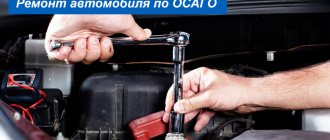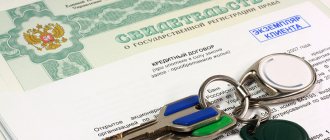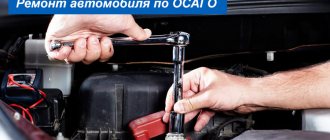Getting ready for the deal
To ensure that the transaction goes through without force majeure, check the documents for the car and the owner. There are scammers among private owners - the car being sold may be stolen, pledged to the bank, or even scrapped. Therefore, before purchasing, ask the seller to provide a complete package of documents:
- original car passport (PTS);
- serial book with VIN number;
- certificate of registration (CTC);
- diagnostic card;
- former or current insurance policy;
- certificate of ownership;
- the seller’s passport or power of attorney from the owner with his contacts.
If the seller cannot provide any documents, it is better to refuse the purchase.
We check the owner
Ask the seller to show his personal passport and compare it with the data in the owner’s documents and the MTPL insurance policy. If the seller is not the owner, ask him to show the owner’s power of attorney and give his contact phone number. Call the owner and ask who the seller of the car is to him, whether the owner gave permission for the sale and the execution of a power of attorney.
To identify a reseller, ask the owner to name the make, model, characteristics of the car, where he bought it and what service center he used to service it. Resellers sell a lot of cars, so they can get confused and give the wrong information. The owner's answers must match the documents.
Checking the VIN at the dealership
The condition of the basic equipment of the machine can be checked at the dealer. Ask the car owner to go with you to the dealership with all the documents for the car. An inspection officer will check the vehicle.
For example, if you buy a Ford Focus sedan, and as a result of checking the VIN belongs to an Audi, the number is fake, and the car may be stolen. The description of the basic configuration must match the characteristics of the car being sold.
If everything is in order with the documents for the car, and the seller inspires confidence, you can negotiate a deal. Let's consider two ways of concluding transactions - with a private owner and a car dealership.
Benefits of notarizing a loan
To protect yourself from possible troubles, the lender prefers to draw up an official document. Certification of a loan agreement by a notary provides many advantages:
- the text will indicate all the necessary details of the borrower (passport details, residential address)
- the interest rate for the use of borrowed funds and the procedure for its payment to the lender (usually monthly);
- the notary will check the borrower’s documents against the database of the Ministry of Internal Affairs and the bankruptcy register, which eliminates the falsification of documents;
- the parties are explained the provisions of the Civil Code of the Russian Federation on the procedure for granting and repaying loans;
- If the borrowers fail to fulfill their obligations, the lender may contact the notary for affixing a writ of execution.
A notarized loan agreement between individuals or, in the case where one of the parties is an organization, relieves the lender of the need to go to court if the borrower fails to pay the debt. The notary's writ of execution gives the loan agreement the force of an executive document. The creditor can submit it to the bailiff service or to the enterprise where the debtor works, as well as to the credit institution where the borrower has an account. The funds will be written off to repay the debt unconditionally.
We conclude a purchase and sale agreement with a private owner
A standard form of a car purchase and sale agreement (SPA) can be easily found in search engines. A notary is not required to register a document, but to be on the safe side, you can sign the documents at a notary's office.
Some drivers sign a certificate of registration directly with the traffic police in order to check the car on the spot for the presence of a “double” and register a new certificate. Ask the owner of the car to come to the traffic police, sign an agreement with him and pay for the purchase upon registration.
Prepare and print out the purchase and sale agreement in advance - 4-6 copies, the transfer acceptance certificate - 2 copies, a sheet of paper for receipt. The buyer needs to give one copy each to the traffic police and the tax office.
How to fill out a purchase and sale agreement:
- write the data in full, without abbreviations;
- do not make mistakes, typos, blots;
- signatures in the contract, acceptance certificate, receipt and PTS must be in the same pen;
- if there is an empty column, put a dash so that in the future the seller does not enter unnecessary data;
- The contract must be completely either printed or handwritten. In the printed version, you can only fill out the fields and add signatures.
- Please include the VIN, make and model of your vehicle carefully.
In the car passport, fill in the owner column. Please provide your details: full name, registration address. Record the date of sale as in the contract. In the “Document of ownership” section, indicate “purchase and sale agreement dated xx.xx.xxxx”. Be sure to sign it yourself and ask the seller to sign it.
Indicate in the contract only the amount you are paying for the car. If it later turns out that the transaction is declared invalid - due to forged documents, a ban on car registration or other reasons, you will only be able to claim the amount specified in the contract.
Before you give the money, ask the seller to write a receipt for the amount he received from the sale of the car. It is better to pay for the purchase through a bank by transferring money to the seller’s card in order to record the transfer of money.
If the seller is not the owner, then a notarized power of attorney for the right to sell on behalf of the owner must be attached to the contract. In this case, the contract must contain the data and signature of the seller, not the owner.
After you sign the agreement, fill out the acceptance certificate. In the list of items, indicate everything that the former owner gives away with the car. Typically the list includes:
- 2 pairs of keys;
- diagnostic card;
- STS and PTS;
- old or current MTPL insurance policy;
- license plate numbers, if the seller gives them with the car;
- 3 copies of the purchase and sale agreement.
If you do not have a certificate or passport, you will not be able to register with the traffic police.
Come to the signing of the contract with a friend or relative: it will be more difficult for an unscrupulous seller to confuse several people.
How to register a used car when purchasing: drawing up an agreement
Preparation of papers is the most important stage of the transaction. But before moving on to it, we advise you to check the owner of the car through a special service. It is possible that enforcement proceedings have been initiated against him, which could lead to restrictions from the traffic police. Because of these restrictions, you will not be able to register the car in your name until the old owner pays off the debts, and the new owner will not be able to register the car with the traffic police.
From the report you will find out whether the owner has problems with the law, whether his passport is valid, whether there are debts and enforcement proceedings. View an example report
There may be a situation in which the bailiffs sent documents to seize the car to the traffic police, but at the time of the transaction the traffic police did not have time to receive these documents or enter data on restrictions into the database. The new owner buys a legally clean car, and the next day the vehicle has restrictions. Until the old owner pays off the debts, the new owner will not be able to register the car with the traffic police.
Let's figure out what documents to fill out when buying a used car. First of all, this is a car purchase and sale agreement. As with any paper business, there are some subtleties here. First, let's look at what data must be included in the document:
- date and place of signing;
- passport details of the seller and buyer;
- full car and title data;
- absence of encumbrances;
- method and terms of payment, as well as transfer of the vehicle.
All lines in the contract must be completed. If any of them are left blank, add dashes. This will protect you from entering data into it without your knowledge.
Also read: How to correctly fill out a used car purchase and sale agreement
Additionally, you can draw up an act of acceptance and transfer of the car, which records the fact of transfer of the vehicle and its condition at that moment, and also confirms that the parties have no claims against each other. Here you need to specify the date and time of transmission. This will insure you, for example, against paying fines for the previous owner.
You need to fill out the papers in three copies: one remains with you, the second with the seller, and the third will be necessary to register the car with the traffic police. It is not necessary to have them certified by a notary. However, you can still turn to him to certify the legality, including the right of both parties to commit it (clause 1 of Article 163 of the Civil Code of the Russian Federation). This is true, for example, in the case when the car is pledged to the bank. If you have any doubts about this, please refer to Part 2, Section 4, Chapter 30, Paragraph 1 of Article 454 of the Civil Code of the Russian Federation.
Another common option is to issue a general power of attorney with the right to sell. This method is usually chosen to reduce costs (both time and money). The principal (owner) transfers the rights to the car to the buyer, while the vehicle remains his property (see Article 185 of the Civil Code of the Russian Federation). It is important to remember that by agreeing to this type of transaction, you are taking a certain risk. The owner can revoke the power of attorney at any time or demand money for the car in case of sale. Problems also often arise in the event of the death of the seller or his recognition as incompetent (ownership in this case passes to the heirs). We advise you to study the situation very carefully.
Also read: How to buy a car using a general power of attorney
We conclude a purchase and sale agreement with a car dealership
Typically, car dealerships themselves register the car with the traffic police and then sell it. But there are other schemes.
The car dealership indicated itself as the owner in the title, but the car is not registered with the traffic police.
When purchasing such a car, you must have a purchase and sale agreement, a payment document, a transfer and acceptance certificate, and a contract of acceptance of the car dealership with the previous owner.
The car dealership is an intermediary.
In this case, the dealer sells the car, but legally it still belongs to the former owner. Ask the dealer to show the commission agreement - a document confirming the right to sell the car on behalf of the owner. If there is one, the car dealership sells the car and prepares the documents itself. If legal or technical problems arise during the paperwork, you will have to personally contact the former owner. The dealership automatically declines all liability.
When a car dealership doesn't own the car and doesn't have a commission agreement, it has no rights to sell.
Preparation of documents for used car insurance
If a used car was not driven for a long time, its owner did not need to take out an insurance policy. Accordingly, when buying a used car, it is not at all necessary that it have insurance. The new owner must receive it. This can be done immediately after passing the technical inspection. It should be noted that the buyer can travel on the road without compulsory motor liability insurance during the first ten days after purchase. It is during this period that the new owner must take out a policy. Although you need to know, if during these ten days the new owner gets into an accident, he will have to reimburse all expenses personally. If this period has expired and the driver continues to drive, he will face a considerable fine.
Although, if the car has compulsory motor liability insurance, you can agree to maintain the current policy. To do this, both parties will need to go to the insurer to reissue insurance to the new owner. It is entirely legal for the former owner to ask for compensation for an insurance period that was not used.
Registration of a used car with the traffic police in 2021
In addition to receiving the policy, the new owner must register the car in his name within ten days.
To do this, you need to contact the traffic police department with a corresponding application. After this, the inspector will make the necessary entry in the PTS and make changes to the registration certificate. If necessary, you can order new license plates. You need to remember that you will have to pay for all these services in the form of state duty. The rule on vehicle registration should not be neglected, because the driver may receive a fine. So, as a first warning, the inspector issues a fine of 500 rubles. In case of repeated violation, you will have to pay a fine, which reaches 1,500 rubles. If after this the driver continues to drive a car without registration, he may lose his license.
Should the contract be certified by a notary?
Just a few years ago, a notary signature on a purchase and sale agreement was mandatory.
Some car enthusiasts, adhering to the old rules, also go to a notary's office. However, today this is not necessary. The Civil Code provides parties to a transaction with freedom of choice. If desired, the parties can agree to have the document certified by a lawyer. There is no prohibition on this. But it should be remembered that the work of specialists includes various services for which you will have to pay. Notary employees not only certify a ready-made agreement, but also help to draw it up correctly. Many citizens want to have a notarial contract because they want to protect themselves as much as possible in this transaction. Although you need to know, even without notarization, the document has legal force. Thus, there is simply no point in spending money and time visiting a notary office.
What documents does the vehicle seller provide to the buyer?
Once the parties have agreed to conclude a deal, the seller must prepare a package of documents.
Usually, the buyer, along with the car keys, receives a title and a registration certificate. Moreover, if it is missing, the new owner can register the vehicle by receiving a new certificate with his data. You will also need an ID from the seller for the transaction. As for PTS, the buyer must be careful here. This important document must be submitted in original. If the seller does not have the original PTS on hand, this should alert you. It is advisable to listen to explanations of why this happened. In general, experts do not recommend purchasing equipment if the seller only has a copy of the title. After all, the car may be secured. Accordingly, the owner cannot sell such a car. If the buyer is presented with the original, you should ensure that there is space to add new information. Otherwise, you will have to issue a new PTS.
All documentation that the buyer receives along with the car must be displayed in the contract itself. As for the buyer, he will need a driver’s license and a personal passport. It is recommended that you ask the seller in advance if he needs copies of these documents. Many people do without them, but some sellers want to get their hands on them.
Main
- Before concluding a contract, check the documents of the owner and the car.
- Check the VIN twice: on the traffic police website and at the dealer.
- It is better to draw up a purchase and sale agreement at the traffic police in order to immediately check the car for the presence of a “double” during registration.
- Record the fact of payment - pay at the bank, through an ATM, take a receipt.
- Don't buy a car from a dealer who doesn't own the car or has a commission agreement. Indicate in the contract only the actual purchase amount.
Photo: unsplash.com, “Behind the wheel”, depositphotos.com











